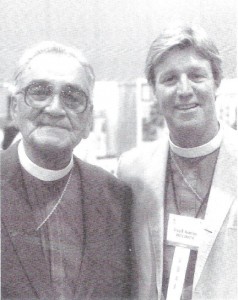“Niobrara Wocekiye Wowapi” is the name in the Lakota/Dakota language of the Sioux Indians for what in English would be “The Niobrara Prayer Book.” Although there has been a Niobrara Hymnal and Catechism for some years, the Wocekiye Wowapi was just published this spring.
After preliminary studies, a translation committee of 16 persons began work on the book in 1988. The Society for Promoting Christian Knowledge (SPCK/USA) raised the funds necessary both for the work of translation and for printing the 92-page paperback volume.
In this book are translations from The Book of Common Prayer 1979 of Daily Morning and Evening Prayer, the Great Litany, Holy Baptism, the Holy Eucharist Rites I and II, the Ordination of a Priest and the Litany for Ordinations. The burial offices and other parts of the prayer book will be added in time. After the Wocekiye Wowapi has been used and tested, some revisions probably will be made, and a hard cover edition printed. The Psalter will then be taken from the American Bible Society’s Dakota translation of the scriptures made in 1919.
The first time the Eucharist in the Wocekiye Wowapi was used was at the Niobrara Convocation in June. This is the annual gathering of Sioux Episcopalians from both North and South Dakota for friendship, reunion, inspiration, and worship which has occurred every year since 1871.
The ministry of the Episcopal Church to the Sioux began in 1859 in what was then known as the Dakota Territory. In 1871, the Rt. Rev. William Hobart Hare was consecrated and sent by the House of Bishops to be the first Bishop of Niobrara.
The second celebration using this Eucharist was July 15, at General Convention in Phoenix. Most of that service was in English, Rite II from the prayer book, but the Eucharistic prayer in Lakota was led by the Rt. Rev. Harold Jones, retired Suffragan Bishop of South Dakota. Bishop Jones was consecrated in 1972, the first Native American to become a bishop in the Episcopal Church. He also gave the blessing in Lakota to the more than 2,000 people present at the service that morning. Lakota and Dakota………..continued
The Living Church

